Posts by: Matin Durrani
The June 2016 issue of Physics World is now out
 By Matin Durrani
By Matin Durrani
Physicists can turn their hands to some unusual subjects. But in the June 2016 issue of Physics World magazine – now live in the Physics World app for mobile and desktop – we reveal the unexpected link between physics and ancient Icelandic sagas. If you don’t believe us, check our cover feature out.
Meanwhile, with the UK referendum on its membership of the European Union (EU) looming, we examine what impact the EU has on UK physics – and how remaining in or leaving the EU could affect the country’s science.
Don’t miss either our review of the new film The Man Who Knew Infinity, while our forum section this month has advice from Barry Sanders of the University of Calgary for how best to collaborate with scientists in China. There’s also a great interview with the new president of the US National Academy of Sciences Marcia McNutt.
View all posts by this author | View this author's profile
The hi-tech way to cycle more easily
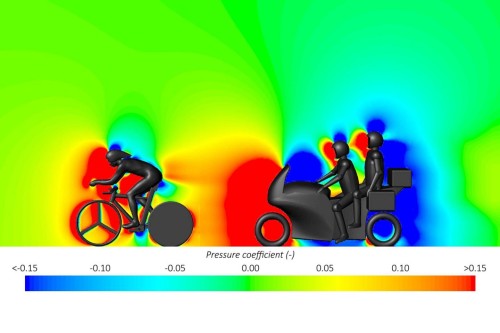
Easy does it: this computer simulation of a motorbike following a cyclist shows a drop in pressure (red area) that cuts the aerodynamic drag on the cyclist by almost 9%. (Courtesy: Eindhoven University of Technology)
By Matin Durrani
Some of the world’s top cyclists are gathering today in the Dutch city of Apeldoorn to take part in the opening stage of the 2016 Giro d’Italia – the 99th running of a race that is one of the three big European professional cycling stage races, along with the Tour de France and the Vuelta a España.
Today’s stage is a short (10 km) time trial and will be followed by two, longer stages in the Netherlands before the action moves to Italy, where the race is due to end on 28 May in Turin. Now, even if you have no interest in cycling – and mine stretches no further than tootling back and forth to work each day – one thing that looks truly scary about professional cycle races such as the Giro d’Italia is the phalanx of motorbikes following in the wake of the cyclists.
These motorbikes can carry everyone from TV camera operators and press photographers to doctors, traffic managers and support staff, all keen to keep as close as possible to the action. Now, however, researchers in the Netherlands and Belgium have discovered that having a motorbike right behind a cyclist could give the latter an advantage. Led by Bert Blocken, a physicist in the Department of the Built Environment at Eindhoven University of Technology, the study reveals that a motorbike at a distance of 25 cm behind a cyclist can cut aerodynamic drag on the person on the bicycle by almost 9%. That amounts to a reduction of almost 3 s for every kilometre travelled. (more…)
The May 2016 issue of Physics World is now out
 By Matin Durrani
By Matin Durrani
Physics stretches from the small to the large, from the simple to the complex and from low energy to high. It spans the entire alphabet too, with this month’s issue of Physics World including everything from the race to produce anti-atoms (A) at the CERN particle-physics lab near Geneva to a study of the physics of zombies (Z).
Zombies don’t exist, obviously. But we look at two physicists – Alex Alemi and Matt Bierbaum – who have studied the statistical physics of how zombies spread. As science writer Stephen Ornes explains, their interest emerged from a fun student project, but has led to a paper in a leading peer-reviewed journal and helped generate a wider appreciation of statistical physics.
If you’re a member of the Institute of Physics (IOP), you can now enjoy immediate access to the new issue with the digital edition of the magazine in your web browser or on any iOS or Android mobile device (just download the Physics World app from the App Store or Google Play). If you’re not yet in the IOP, you can join as an IOPimember for just £15, €20 or $25 a year to get full access to Physics World digital.
View all posts by this author | View this author's profile
The field that could improve your research ‘impact’

Where physics meets food: preparation of ice-cream in a factory. (Courtesy: iStockphoto/Leonid Shcheglov)
By Matin Durrani
As Physics World editor, I spend most of my time covering science that I have never been involved in. I might write articles about astrophysicists, interview atomic physicists or edit features by particle physicists, but it doesn’t mean I’ve ever done any research in those fields.
It was therefore a pleasant change last Friday to attend a summit organized by the Institute of Physics, which publishes Physics World, on physics in food manufacturing. Back in the 1990s, I did a PhD with Athene Donald at the Cavendish Laboratory in Cambridge on the physical properties of mixtures of gel-forming biopolymers – materials that apart from being interesting from a fundamental point of view are also relevant to the food industry.
Many foods, after all, are complex, multicomponent mixtures – and if you can understand how they behave, then you can create foods that are healthier, cheaper and perhaps even tastier too.
Michael Berry at 75
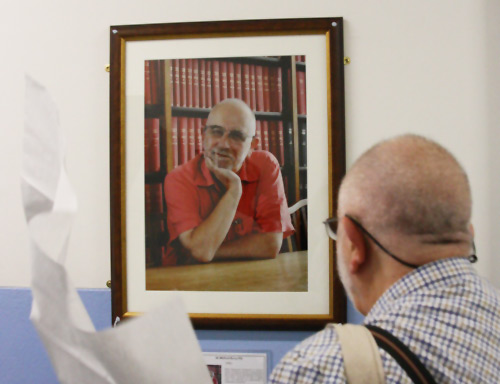
A moment to reflect – Michael Berry unveils a framed photograph of himself in the University of Bristol at an event to mark his 75th birthday. (Courtesy: Brian R Pollard)
By Matin Durrani
Anyone who gets invited to an event that’s being held on April Fools’ Day is bound to think there’s something fishy going on. But last Friday’s meeting to celebrate the 75th birthday of Bristol University physicist Michael Berry was a genuine commemoration of his career, although it did have its lighter moments.
Grandly entitled “Physics, Art, Mathematics, Science”, the meeting was intended to reflect Berry’s extensive and wide-ranging interests, which stretch from the physics of waves and quantum phenomena to optics, tidal bores and magnetic levitation. (There’s also a phenomenon called the Berry phase, although I understand Berry himself is reluctant to use that term.)
It’s difficult to summarize Berry’s many contributions to physics – he has written approaching 500 papers – so I’m going to take the easy way out and instead point you at his excellent website, where you can easily get lost down lots of entertaining and stimulating rabbit holes.
If there’s one item on his site I can recommend, it’s his description of how his work on the mathematics of magnetic levitation led him to share the 2000 IgNobel Prize for Physics with the future (genuine) Nobel laureate Andre Geim, who in 1997 levitated a frog using a powerful permanent electromagnet while at Bristol.
View all posts by this author | View this author's profile
The April 2016 issue of Physics World is now live
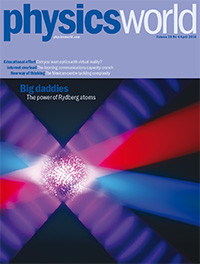 By Matin Durrani
By Matin Durrani
The April 2016 issue of Physics World magazine is ready and waiting for you to access via our app for mobile and desktop.
Our cover story this month is about Rydberg atoms – those super-sized atoms that are one of the hot topics in condensed-matter physics – and in particular how they could be used to create quantum computers.
You can also find out how virtual-reality tools could help you to learn about the science of optics and learn more about a new research centre at the National Autonomous University of Mexico that’s bringing a fresh approach to the science of complexity.
If you’re a member of the Institute of Physics (IOP), you can now enjoy immediate access to the new issue with the digital edition of the magazine in your web browser or on any iOS or Android mobile device (just download the Physics World app from the App Store or Google Play). If you’re not yet in the IOP, you can join as an IOPimember for just £15, €20 or $25 a year to get full access to Physics World digital.
The firm that’s made no noise over gravitational waves
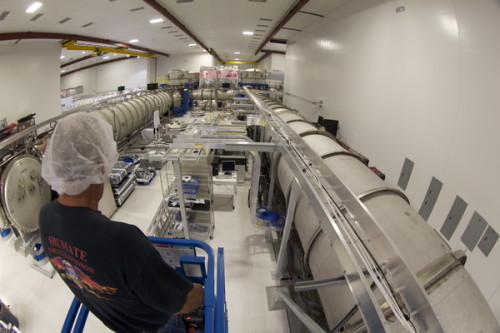
Power me up: Kepco’s kit was used to convert mains AC into DC for the lasers, electronics and other instrumentation at LIGO. (Courtesy: Caltech/MIT/LIGO Lab)
By Matin Durrani in Baltimore, Maryland, US
The exhibition hall at this year’s APS March meeting is so big that it can be hard to know who or what to see among the many companies displaying their wares or services. Fortunately, my colleague Joe Breck from IOP Publishing’s office in Philadelphia tipped me off about a great little story featuring Kepco Power Supplies, which is based in Flushing, New York.
I spoke to Mark Kupferberg, executive vice-president for power solutions at the firm, which was founded by his father and his two brothers in 1946 shortly afer the three had finished work on the Manhattan atomic-bomb project. Kepco mainly makes power supplies that convert mains AC into DC electricity, and has recently played a small but vital role in the discovery of gravitational waves, which were first predicted by Einstein 100 years ago.
APS launches LGBT Climate in Physics report
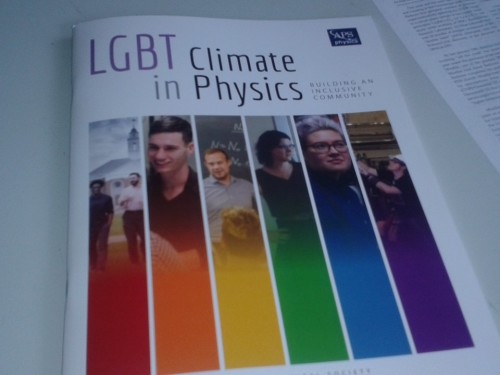
Lifting the lid: the LGBT Climate in Physics report launched at the APS March meeting.
By Matin Durrani in Baltimore, Maryland, US
I’ve been thinking a lot recently about the make-up of the physics community, particularly as this month saw Physics World publish a special issue, “Physics for all: building a more inclusive discipline”, that examined ways to make physics as welcoming as possible for everyone. It looked, for example, at “microaggressions” in physics, the role of unconscious bias and whether physics is just for people from better socioeconomic backgrounds.
One article that attracted particular attention – based on informal feedback and e-mails I’ve received since the issue came out – was “Where people and particles collide”. Written by my Physics World colleague Louise Mayor, it looks at what life’s like for gender and sexual minorities at the CERN particle-physics lab in Geneva and the challenges people there faced in setting up an official LGBT Cern Club. (There is still no such club, but CERN has set up an LGBT “informal network”.)
The issues facing gender and sexual minorities have also been a theme here at the APS March meeting, with the launch this morning of a new APS report LGBT Climate in Physics. The report is based on focus groups, a “climate survey” of more than 320 members of the US LGBT physics community, and follow-up interviews with five survey participants. A further 2596 members of the entire APS community replied to a separate survey, of whom 2.5% identified themselves as LGBT.
View all posts by this author | View this author's profile
Steven Weinberg defends his ‘Whig’ view of history
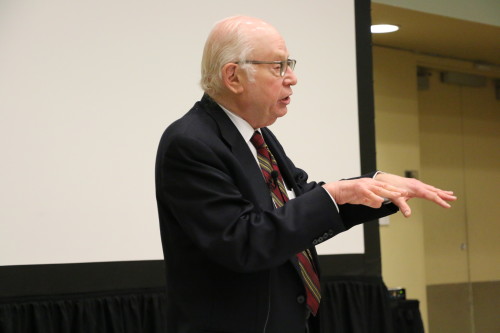
Steven Weinberg in full flow discussing his view of the history of physics.
By Matin Durrani in Baltimore, Maryland, US
I wasn’t planning on blogging about the talk that the Nobel-prize-winning physicist Steven Weinberg gave yesterday afternoon here at the APS March meeting. He’d been speaking about his recent book To Explain the World: the Discovery of Modern Science, which examines the history of physics from the ancient Greeks to the present day.
The book ruffled a fair few feathers when it was published last year, with historians and philosophers annoyed at Weinberg’s approach to history, which basically involves judging the past from the standpoint of the present. It’s known as the “Whig interpretation” of history and sees past events as a march towards enlightenment, ignoring dead-ends and blind alleys. It’s the history of winners, if you like.
I have probably mis-stated the criticisms of Weinberg book – I’m no historian – and that’s my point. I felt the arguments against his approach were too subtle and nuanced to fit in a blog. But I changed my mind this morning about covering the session Weinberg appeared in. Not only because the room where Weinberg gave his talk was full to bursting, with about 500 people present, but also because some of the things he said, which I Tweeted yesterday, were proving popular on Twitter. Clearly, people want to hear what Weinberg says – he’s a master of the soundbite – so here, for posterity, are a few of his thoughts.
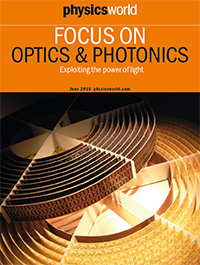 By Matin Durrani
By Matin Durrani